proper shoe fitting
AUTHOR: Marc Mitnick DPM home --> proper shoe fitting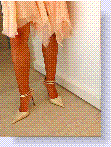
It amazes me every day as to the number of patients I see who have foot and leg problems due nothing more than from the types of shoes that they are wearing.
Just because a shoe "looks" comfortable and is expensive is not the criteria to use when purchasing shoes. A proper fit, proper materials, and solid construction of the shoe is essential. A shoe that is comfortable for one person may be totally uncomfortable to the next person due to nothing more than the difference in foot structure between the two people. Click here for more information on different types of foot structure.
We are all looking for that natural feel to a shoe to maximize comfort but unfortunately there is nothing natural about wearing shoes. We were not designed to be "shoe wearers" but unfortunately (or fortunately) society necessitates that we wear shoes mainly for protection and secondly for style.
The purpose of this discussion is not to be your fashion consultant. I learned a long time ago that "preaching" about the best shoe to wear particularly to a fashionable woman was pretty much a waste of time. Having said that, you cannot imagine how many elderly women have said to me that they wish they had worn proper shoes when they were younger to avoid the problems they are now having.
Statistically, more women visit podiatrists than men and part of the reason for that is due to the difference in the type of shoes both sexes wear. Again, it comes down to a theme that I use throughout this web site; it is like trying to put a square peg into a round hole.
Look at the picture to the right of a foot x-rayed in a high heel shoe. Now that can't be comfortable, can it?
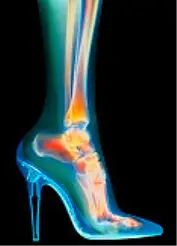
So....what about those of you who are reading this discussion and saying to yourself that you do wear good shoes but your feet still hurt? Again, most times those "good" shoes may not be the best shoes for your type of foot structure.
shoe fitting the infant
Since all of us start out as infants, lets start with their feet. At crib age only a loose fitting booty is necessary and this is more for warmth than anything else. Initially, when the toddler begins to walk at about one year, he/she should be encouraged to walk barefoot at least inside the house and with shoes outside the home in order to protect the feet. Walking barefoot is the most natural way for feet to develop.
It is very important the child's shoes should be expertly fitted. Between wearing proper shoes and going barefoot the child's feet will become conditioned to wearing shoes.
Between one to two years of age the child should be in a flexible shoe alternated with a booty. From two to three years of age they should alternate between, a firm shoe, flexible shoe and a booty. After three years of age they can go to an athletic type shoe along with a flexible shoe and a firmer shoe.
shoe fitting teenagers and adults
In teenagers and adults a properly fitted shoe should have the widest part of the foot fit at or just behind the widest part of the shoe. The reason some feet can be just behind the widest part of the shoe is to make up for those who happen to have longer toes. When standing there should be a small amount of room between the longest toe and the end of the shoe. Keep in mind that the big toe is not always the longest toe.
There should also be adequate height in the toe box. If any of the toes are rubbing on top of the shoe the potential for foot pain exists.
Your heel should fit snugly into the back of the shoe. This is necessary to stabilize the heel when you walk in order to cut down on excessive motion in the foot. This, by the way, is one of the main components in expensive running shoes.
Foot shape should fit shoe shape. Makes sense, right? In this day and age of mass production, most shoe manufactures have gone to a straight last shoe with no differentiation in the forefoot area. To compensate for that, many people will buy a shoe that is wider than they actually need in an effort to buy that particular shoe. The problem with that line of logic is that the foot may slosh around in the shoe causing irritation to the foot in the form of corns, calluses or blisters.
Many people make the mistake of buying a shoe that has a last that is too narrow for their particular foot structure. I am constantly pointing this out. Stand in your shoe; if any part of the outside of the foot overhangs the outer sole of the shoe you are inviting trouble in the form of pain.
Shoe material is also a consideration when purchasing the proper shoe. Durability, flexibility and breathability of the material has to be accounted for in the upper material. Deerskin, for example, tends to be more forgiving but less durable than other type of leathers. Very stiff leathers have no "give" to them and can be uncomfortable. People with very arthritic, bony type feet have to look for materials that will mold to their foot structure and thereby take pressure off of the deformity. Of course, as stated previously, a shoe with a high toe box will also go a long way to protect this area of the foot.
People who have feet that perspire a lot need to find materials that breathe in an effort to get air to the feet during the day. In this day and age there are innersole materials which are hydrophilic, meaning they absorb perspiration away from the foot. This can go a long way to cutting down on the incidence of athletes foot and dermatitis. Naturally for those people whose feet perspire a lot, you should allow your shoes to thoroughly dry out before wearing them again. A good idea is to leave them near an open window or on the porch; most people make the mistake of throwing their perspiration laden shoes in the dark closet where they never fully dry out. These same people should avoid wearing high top shoes and boots.
The sole of the shoe is also a major consideration. I find I have a lot of people coming in with foot problems, generally on the bottom of the foot that is due to the sole either being too stiff or too flexible. Said another way, the sole should have bend to it but not excessive bend. Boat or deck shoes are one of my least favorite shoes because of the excessive bend in the forefoot; it is the source of a lot of foot pain symptoms.
When standing barefoot roughly fifty percent of body weight rests on the heel and the other 50 percent on the ball of the foot. When you then put the foot into a shoe, the higher the heel on the shoe, the greater the portion of body weight that distributes to the ball of the foot and away from the heel. Therefore, a lower heel gives better weight distribution. Excess weight distribution is also a source of foot pain, primarily forefoot pain.
One way to counter the unequal distribution is through an arch support or prescription orthotics which picks up some of the body weight in the midfoot and reduces the pressure on the heel and ball of the foot. For those of you who already wear orthotics you well know that they require a closed shoe, so what happens when you want to wear a sandal and your orthotics will not fit. The solution is to wear a sandal that has a built in orthotic.
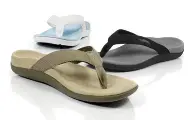
|
Since the biggest cause of foot problems is pronation, a sandal that forces the foot out of pronation may be the answer to allow you to go without your orthotics and still be comfortable.
Anatomically speaking, women tend to have narrower feet than men. Women are constantly complaining about the inability to find shoes that "stay on". Should a women develop a bunion or tailors bunion, this further widens the forefoot relative to the rearfoot and makes it even harder to find shoes. At this point many women have to resort to laced shoes in order for the shoe to stay on their feet.
When shopping for shoes most people make the mistake and look for a shoe in one size. Your feet should always be measured at the time of purchase and you should try and purchase your shoes at the end of the day when they are most swollen. A shoe that is uncomfortable at 8:00 a.m. may be very uncomfortable by 8:00 p.m. Secondly, in this day and age, shoes are made all over the world and not all shoes correspond to American sizes. If you look closely at the shoes or their boxes, particularly athletic shoes, you will see that they are listed in multiple sizes; American, European, etc. So, buy the shoe according to the criteria of how it fits, not by the shoe size number written on the box.
Many times during the course of conversation a patient will show me that their shoe is worn out in the wrong area of the heel. They point to the wear on the posterior-outside of the heel, thinking that normal heal wear is directly on the back. This is not the case. Look at the picture below. We walk with one foot in front of the other, relative to the mid line of the body, so normal heel strike is on the posterior-outside of the shoe. Excessive heel wear on the back or even the posterior-inside of the heel is indicative of excessive pronation.
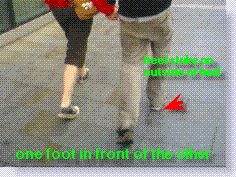
|
As a final thought, although I have no hard statistics, I would say the biggest cause of foot or leg pain in the athlete is from wearing athletic shoes that have worn out. It amazes me over the years how many times I told an athlete to try a new pair of athletic shoes and their problem miraculously disappeared. Athletic shoes are designed to afford the foot certain protection that regular shoes do not. Once the shoe has worn out, the protection is lost and pain comes in.
See also measuring your foot size
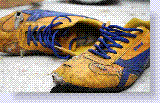
Click here for humorous anecdotes on shoes.
REFERENCES
Want more information? CLICK HERE


Recent Articles
-
Vitamin D impact on health
Feb 06, 23 07:17 PM
Researchers are suggesting that the effectiveness of Vitamin D in fighting and preventing disease is predicated on a persons body mass index (BMI). The thinner the person the greater the positive impa… -
Foods to speed up healing
Feb 01, 23 02:41 PM
One of the best ways to help yourself heal faster after surgery is to eat well. Getting the proper nutrition will provide your body with the essentials it needs to promote healing. Here is a suggestio… -
Cancer and Type 2 Diabetes
Jan 25, 23 04:52 PM
An article revealing that older type 2 diabetics have a higher incidence of cancer then non-diabetics. It is suggested that cancer may surpass CVD as the number one cause of death in older diabetics. -
Does glucosamine or MSM reduce arthritis pain?
Jan 22, 23 01:41 PM
A good review of the possible benefits to taking glucosamine, chondroitin or MSM for arthritis. Always beware of the possible side effects of over the counter supplements. -
shin splints
Jan 18, 23 05:12 PM
A great review on the various causes of shin splints, along with treatment options. -
Whats new in skin cancer?
Jan 15, 23 08:32 PM
A presentation of newer skin protection combinations in an effort to better protect the skin from the hazards of sun exposure. -
Causes and risk factors of warts
Jan 14, 23 05:02 PM
A good review of the causes of warts and protective measures you can take to prevent developing them. -
Do chronic wounds need to be dressed daily?
Jan 11, 23 02:18 PM
Because of supply chain shortages as well as staffing shortages particularly during the pandemic, many institutions extended the time between dressing changes for chronic wounds. Is this really the be… -
Food choices that raise your risk of type 2 diabetes
Jan 08, 23 10:07 AM
A good review of how blood sugars can become elevated and the harm that can do. Certain food groups have a tendency to raise your blood sugars and should be avoided. -
Outcome stats from Scarf bunionectomy
Jan 03, 23 03:04 PM
The Journal of Foot and Ankle Surgery recently reported a meta analysis of outcomes in 1583 Scarf bunionectomies that met their inclusion criteria. Adverse events did not seem to be any better or wors…